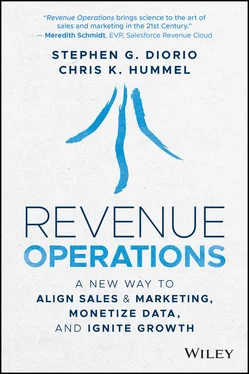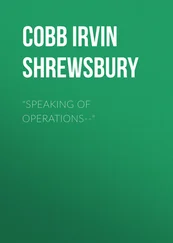Stephen Diorio - Revenue Operations
Здесь есть возможность читать онлайн «Stephen Diorio - Revenue Operations» — ознакомительный отрывок электронной книги совершенно бесплатно, а после прочтения отрывка купить полную версию. В некоторых случаях можно слушать аудио, скачать через торрент в формате fb2 и присутствует краткое содержание. Жанр: unrecognised, на английском языке. Описание произведения, (предисловие) а так же отзывы посетителей доступны на портале библиотеки ЛибКат.
- Название:Revenue Operations
- Автор:
- Жанр:
- Год:неизвестен
- ISBN:нет данных
- Рейтинг книги:3 / 5. Голосов: 1
-
Избранное:Добавить в избранное
- Отзывы:
-
Ваша оценка:
- 60
- 1
- 2
- 3
- 4
- 5
Revenue Operations: краткое содержание, описание и аннотация
Предлагаем к чтению аннотацию, описание, краткое содержание или предисловие (зависит от того, что написал сам автор книги «Revenue Operations»). Если вы не нашли необходимую информацию о книге — напишите в комментариях, мы постараемся отыскать её.
Revenue Operations: A New Way to Align Sales and Marketing, Monetize Data, and Ignite Growth
Revenue Operations
Revenue Operations
Revenue Operations — читать онлайн ознакомительный отрывок
Ниже представлен текст книги, разбитый по страницам. Система сохранения места последней прочитанной страницы, позволяет с удобством читать онлайн бесплатно книгу «Revenue Operations», без необходимости каждый раз заново искать на чём Вы остановились. Поставьте закладку, и сможете в любой момент перейти на страницу, на которой закончили чтение.
Интервал:
Закладка:
The financial criteria for allocating growth resources, OPEX, and CapEx across these disparate functions differs wildly.
Change is everywhere. Not only does change scare people, but it raises questions about whether the benefits of transformation are worth the pain.
Real-world problems are interdependent and interdisciplinary. Regardless of what its org chart looks like, any business needs to manage the entire revenue cycle as an integrated whole before, during, and after the transaction.
The digital selling infrastructure, including the customer experience and data it generates, has become one of the biggest growth assets, even if ownership is unclear.
Investors, owners, and boards need more predictable and forward-looking forecasts.
Consistency, repeatability, and automation could help ensure that good performance is sustainable over time and scalable.
Marketing: Increasing Ambiguity
Telling the company story, getting the offer in market, and orchestrating the customer experience. These are valuable activities that all contribute to demand generation and firm value. In a digital world where innovation, trust, and customer experience matter more, the perceived value of marketing activities has increased, yet budgets are shrinking, and the scope of the function is fluctuating.
A relatively recent invention of the twentieth century, the Chief Marketing Officer (CMO) role has changed dramatically over the course of its short span of existence by shifting from managing media and building brands and demand in the last century to curating the customer experience in digital channels and managing customer analytics in the modern era.
At its best, Marketing should be a commercial function that delivers significant, tangible impact on the business performance of a company, affecting both revenue and valuation. Whether you're the CMO, a brand manager, or a creative specialist, the role can be exhilarating, frustrating, intellectual, administrative, strategic, creative, scientific, powerless, and game-changing – usually all of these and often simultaneously. Transformation is happening, and many fronts are moving. Ambiguity is a marketer's constant companion. Why?
The skill sets in marketing are in flux. Technology, data overload, market noise, and fluctuating channels combine with massive variation in budgets, metrics, decision rights, organizational structure and incentives to present existential challenges.
The marketing toolset has democratized. Other departments and functions can now execute “marketing” activities on their own, blurring areas of collaboration.
The marketing mix has changed. Digital marketing technology infrastructure and the people data analytics and content required to support them now command the bulk of marketing budgets. Also, the budget allocated on “owned marketing” – where the company controls the message 100% – now exceeds paid media.
Marketing doesn't fully control the digital channels needed to do their job. Most customer engagement now happens in digital and contactless channels, but in most cases marketing does not own or manage the systems, data assets, and blueprint for these increasingly important systems.
We all lost control of the buyer's journey. While the idea of a linear demand funnel is archaic, marketers can still influence the buyer's journey having an engagement model for wherever the customer wants to go.
Organizational “flashpoints” are increasing in breadth and depth. The tussle over marketing's intersections with product, digital, sales, and service teams challenges management structures.
Every marketing organization has a customized, unique structure. Collaboration with peers can suffer when the size, scope, activities, and mandate of every marketing organization fluctuate constantly. Culture evolves organizations that are as unique as a fingerprint.
Marketing leaders need to recognize that these ambiguities weigh on marketing personnel and their peers across the company. At its most impactful, marketing orchestrates – engaging with all other parts of the company, providing holistic views of the customer perspective, and amplifying the best of the organization to create a whole that is greater than the sum of the individual parts. Otherwise, like a decaying satellite, the marketing function will continue to appear quite sophisticated and even cool from the outside as it inexorably heads toward its own demise.
Sales: Rising Complexity
Sales teams are tasked with converting interested prospects into transacting customers, increasing revenue per account, and managing relationships to increase loyalty and trust. These activities exist at the center of any drive to expand revenues.
Sales is a powerful function. The skill sets of sales reps, account managers, and other sales personnel can vary widely, though, and often depend on the sales model, product sophistication, and buying cycle. Because sales manages the pipeline of business, it has unparalleled visibility of the upcoming revenue streams. It also represents the “last touch” before the transaction with the customer. Sales leaders leverage that control point to exercise authority in many areas beyond their official remit. The surety of that dominant position, however, is now starting to fade as sales confronts transformation in its own area.
Selling has become more capital intensive. More buying happens within digital channels, and sales people rely on analytics and automation to engage customers with the speed and personalization they demand. Sales leaders now hold two responsibilities: managing both sellers (the people) and selling (the system).
Selling has become a complex team sport. No single organization controls all of the revenue growth levers, so the ability to move information quickly between functions helps get marketing, sales, and service silos working as one revenue team with a single common purpose.
Selling teams are more distributed, digital, data driven, and dynamic. The role of sales has evolved to rely more on digital channels and collaboration technologies and less on planes, trains, and automobiles over time. The recent pandemic has only accelerated the move to sell bigger and more complicated products through digital channels. It has also created a skill gap for sales leaders and people who did not grow up with the skills to be effective in this environment.
More business models create more revenue streams going through more channels. New approaches like subscriptions open up alternative and derivative products that can be monetized more and more through owned digital infrastructure outside of and in parallel with any traditional sales channels.
We lost visibility of what the customer is doing. The volume of data we now collect on customer interactions dwarfs what we've been using to analyze transactions, but the fragmentation of that engagement data actually creates gaps in visibility for the sales teams that frustrate their efforts for a 360-degree understanding of their customers.
The old-school “art of selling” is struggling against the new school analytics. Like the battles in Major League Baseball between grizzled old scouts and the new crop of data-driven analysts, the utility of many historical traits once considered critical for performance in sales are now being questioned as the selling process becomes more engineered.
Selling now requires less human interaction to enhance relationships. The increasing automation of customer engagement, when used effectively, should unburden sales people from many administrative or low-value activities. Sellers now need to balance the volume, content, and frequency of digital interactions with person-to-person outreach to find the optimal revenue yield.
Even where sales leaders recognize the value of other functions in driving more and/or bigger transactions, they struggle with a lack of access to full information on all the touchpoints with customers. Technology needs to be seen as more of an asset than a tool. At its peak value, sales can act as a true customer advocate, serving as the bridge between customer and company and using its performance-driven culture to push accountability across all functions to serve the customer's needs. If not, sales may find itself stranded as the king of an increasingly less relevant hill.
Читать дальшеИнтервал:
Закладка:
Похожие книги на «Revenue Operations»
Представляем Вашему вниманию похожие книги на «Revenue Operations» списком для выбора. Мы отобрали схожую по названию и смыслу литературу в надежде предоставить читателям больше вариантов отыскать новые, интересные, ещё непрочитанные произведения.
Обсуждение, отзывы о книге «Revenue Operations» и просто собственные мнения читателей. Оставьте ваши комментарии, напишите, что Вы думаете о произведении, его смысле или главных героях. Укажите что конкретно понравилось, а что нет, и почему Вы так считаете.











